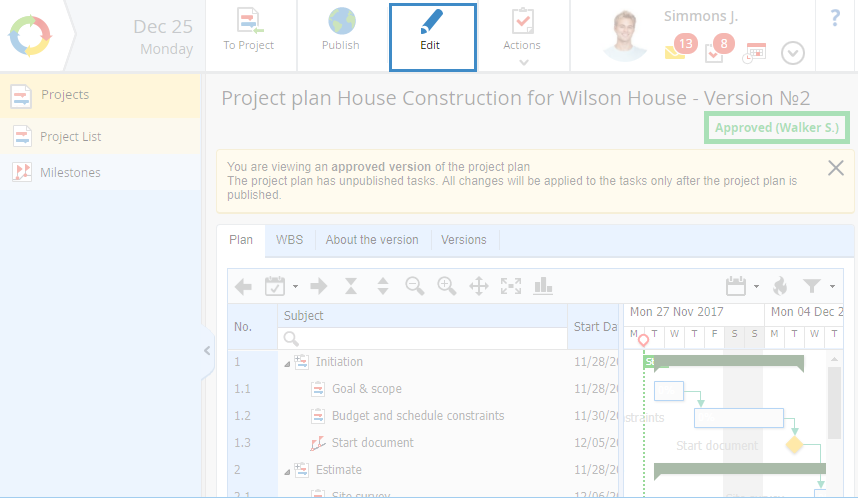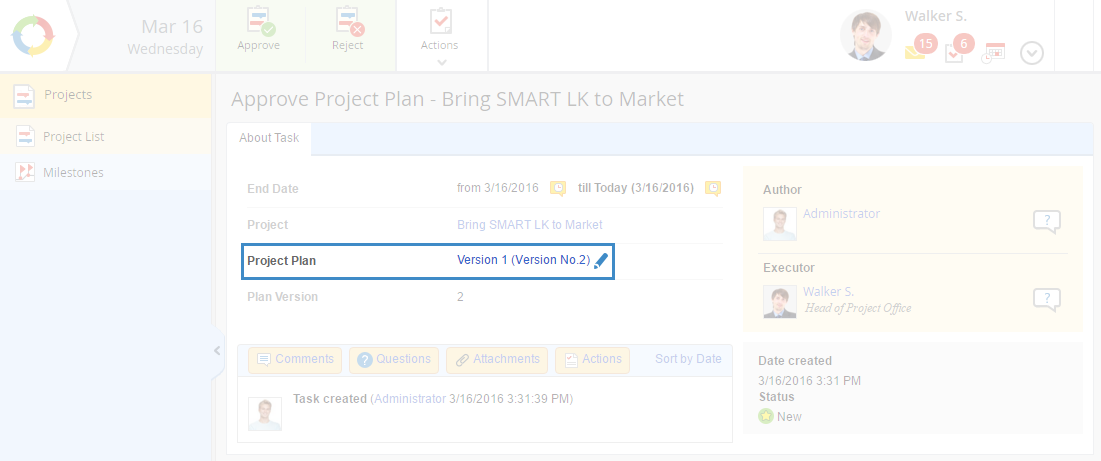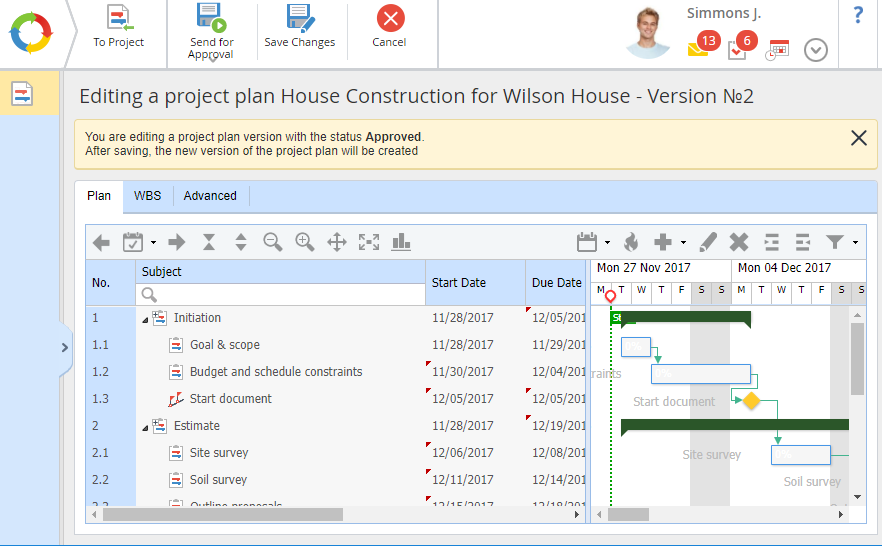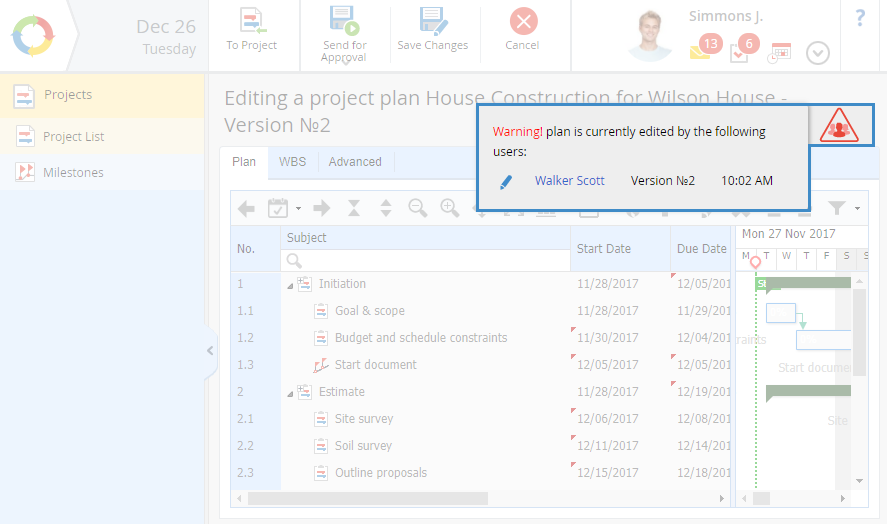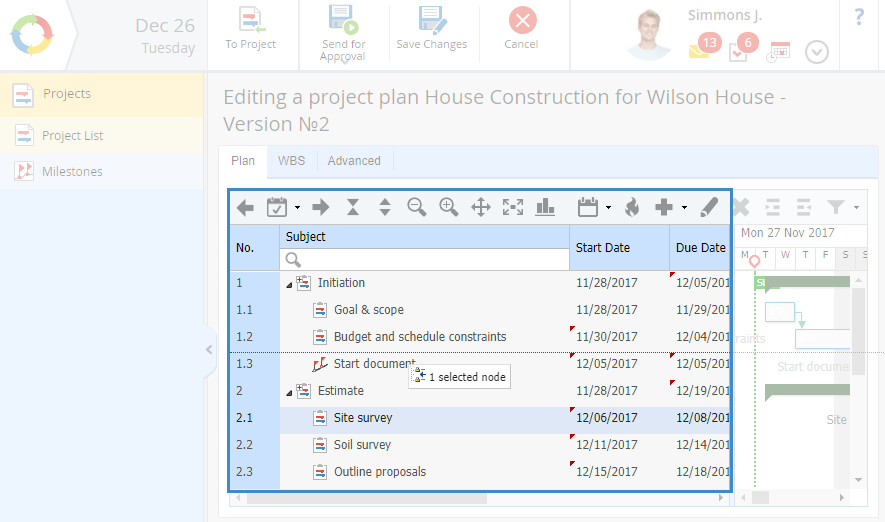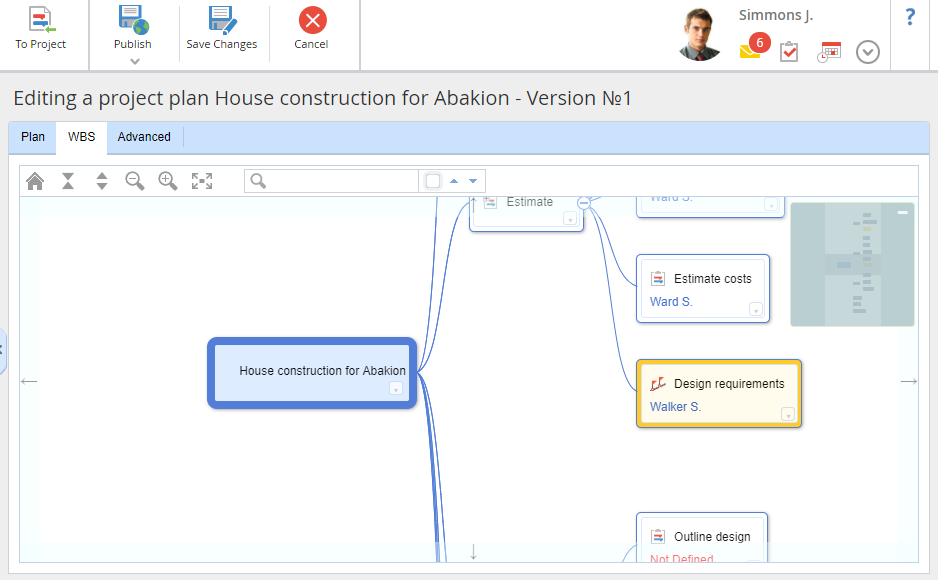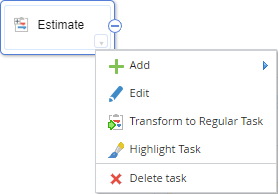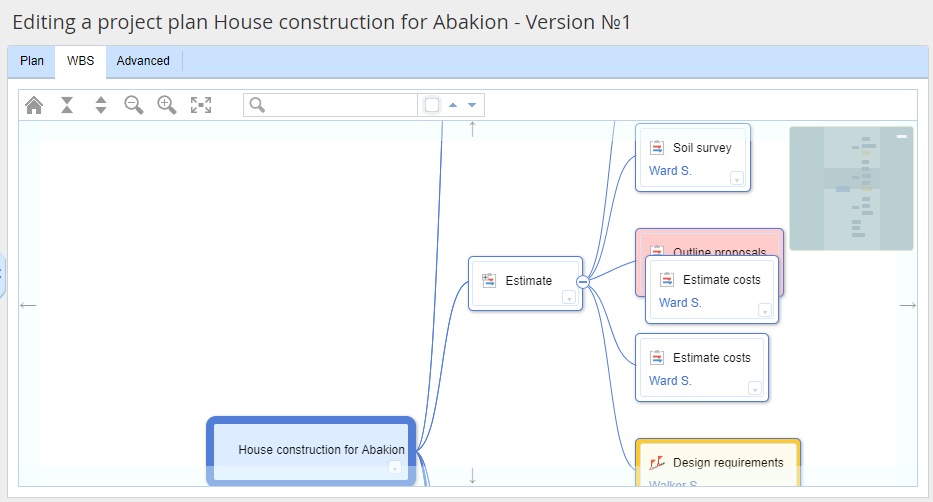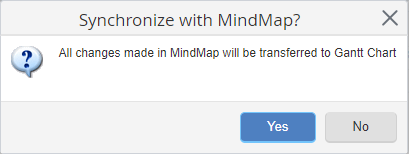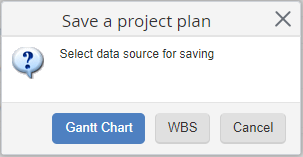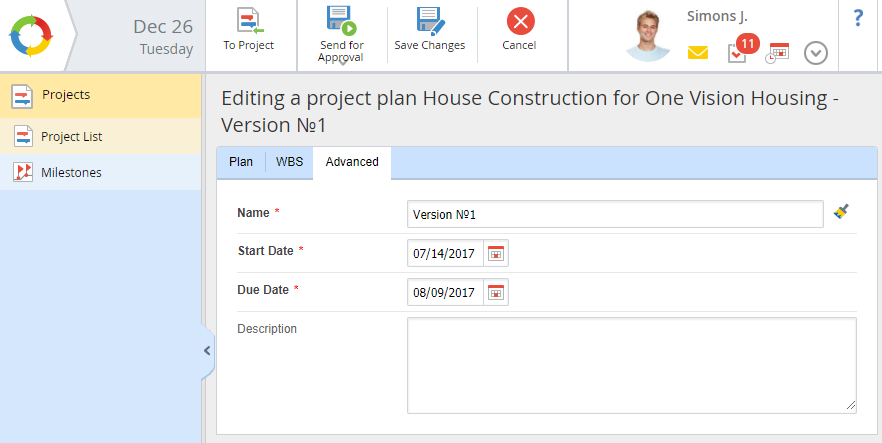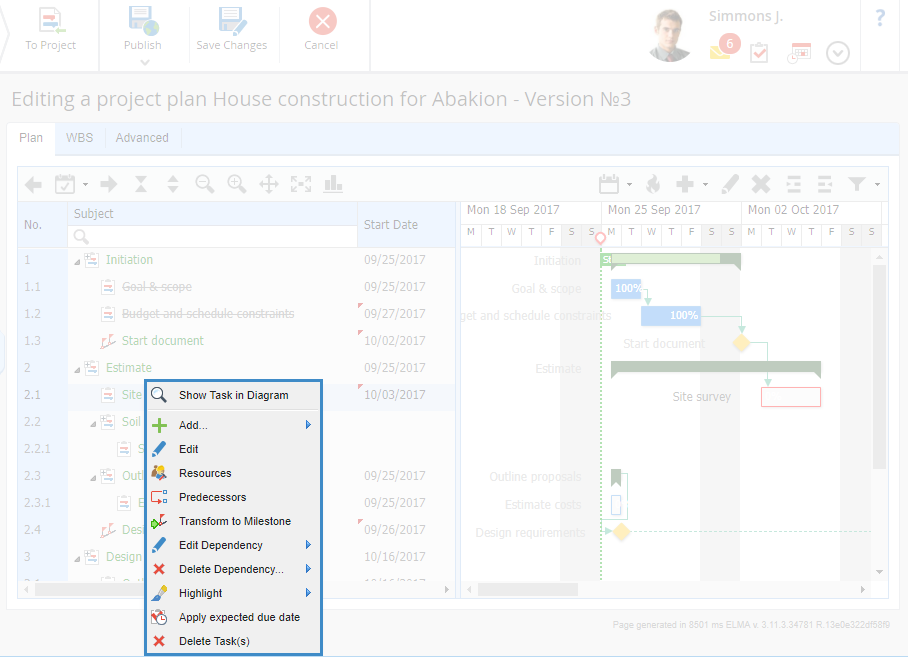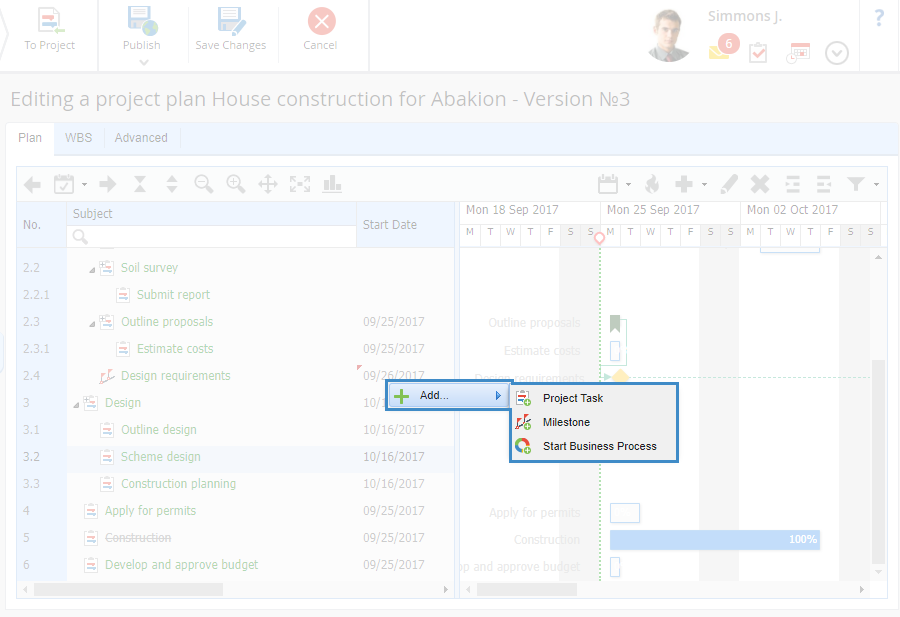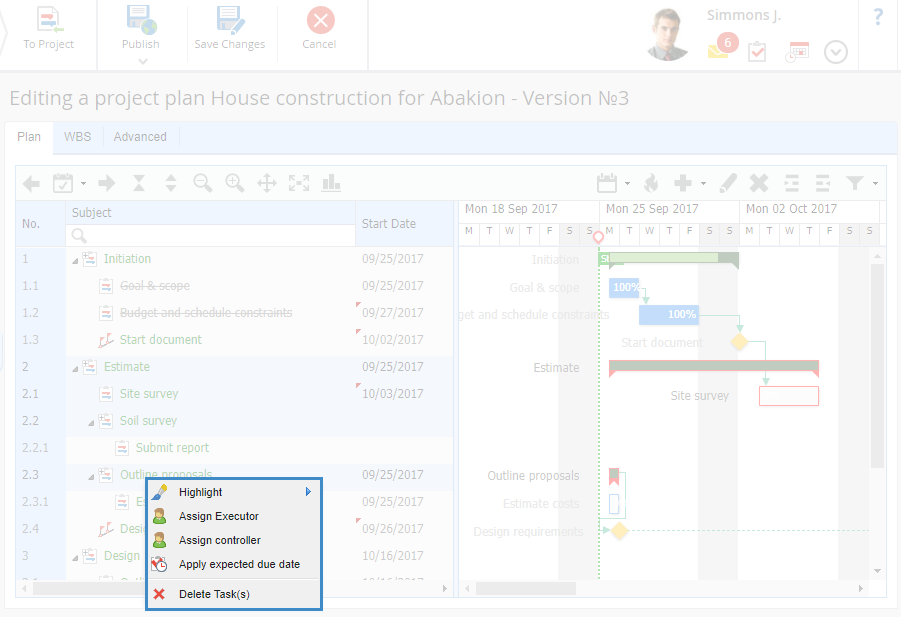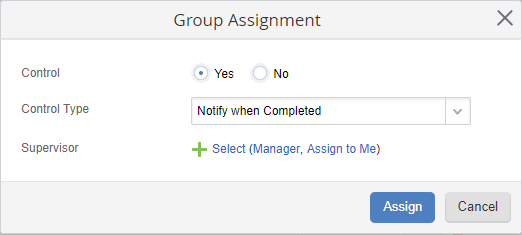There are several ways to start editing a project plan:
-
|
|
|
Fig. 1. Project plan page. Edit button
|
-
click  on the page of project plan approval task, in the Project Plan field (fig. 2);
on the page of project plan approval task, in the Project Plan field (fig. 2);
|
|
|
Fig. 2. Project plan approval task. Project Plan field
|
-
select the required project on the resource optimizer page. The plan of the selected project will be available for editing (fig. 3). The edited projects have the  icon next to their names.
icon next to their names.
|
|
|
Fig. 3. Resource optimizer page. Project plan context menu
|
Project plan editing page looks like this (fig. 4):
|
|
|
Fig. 4. Project plan editing page
|
If a project plan version is simultaneously edited by several ELMA users, the top right corner of the page will display a notification about it (fig. 5). When you mouse over this notification, a window pops up (fig. 5) with information on the users, who are editing this project plan version. To learn more, see the respective Help section.
|
|
|
Fig. 5. Project plan editing page. Simultaneous editing notification
|
After editing a project plan, you have to publish it, to apply the changes. The project editing page includes three tabs: Plan, WBS and Advanced.
The Plan tab (fig. 4) displays the task list of the current project plan and the Gantt chart. To edit tasks on this tab, use the context menu or the toolbar buttons.
Tasks on this tab have the following graphic scheme:
-
completed tasks have grey, strike out font;
-
active tasks that have been assigned and visible to the user have blue font;
-
not started tasks, not available to the user have green font.
-
created but unpublished tasks are black.
To edit the tasks hierarchy, use the  and
and  buttons in the toolbar, or just drag the tasks to the required position (fig. 6).
buttons in the toolbar, or just drag the tasks to the required position (fig. 6).
|
|
|
Fig. 6. Project plan editing page. Dragging tasks in the list
|
This tab (fig. 7) shows a mind map of project tasks, generated according to the project plan.
Fig. 7. Project plan editing page. WBS tab
To edit tasks on this tab, use the context menu of each task. To open the context menu, click on the

icon, in the bottom right corner of the required task. An example of the task context menu is shown in fig. 8.
Fig. 8. WBS tab. Task context menu
To change the
task hierarchy, drag tasks to the required places on the diagram (fig. 9). The place where a task will be moved is highlighted pink.
Fig. 9. Project plan editing page. WBS tab. Dragging tasks
When editing the WBS you can use hot keys. Select a task and use one of the combinations:
|
Keys
|
Action
|
|
Tab
|
Create a subtask.
|
|
Shift + Delete
|
Delete the task.
|
|
Delete
|
Delete the name of the task.
|
|
Shift + Enter
|
Create a new task on the same level.
|
Press Esc to cancel the last action (e.g. if you press Esc after creating a task, the task will be deleted).
Note, that the changes you make on this tab are not automatically applied to the project plan tasks (on the Plan tab) and vice versa. It allows you to maintain version control when editing and avoid making changes by mistake.
To fully apply the changes, you need to synchronize the WBS and Plan tabs. To do so, go from the tab where you've been making changes to the tab to synchronize with. A dialog box will open (fig. 10), where you need to confirm synchronization.
Fig. 10. Confirmation dialog box
If you don't need to synchronize tabs, click
No. In this case, the data on the tabs will be different. When saving/
publishing the edited project plan, a dialog box will open, where you need to select a source to save (
WBS or
Plan tab)
.
|
|
|
Fig. 11. Selection dialog box
|
On the Advanced tab (fig. 12), you can change the name of the project plan version and the project start and end dates. You can also add a description of this project plan version.
|
|
|
Fig. 12. Project plan editing page. Advanced tab
|
Top menu buttons
|
|
Return to the project page. |
|
|
|
|
|
Save the project plan and publish it. |
|
|
Save the project plan.
|
|
|
Cancel editing the project plan.
|
On the project plan editing page, you can open the context menu in the task list or in the
Gantt chart. The items of the context menu depend on where you open it.
For example, the context menu of a task looks like this (fig. 13):
Fig. 13. Project plan editing page. Task context menu
Show Task in Diagram – highlight the selected task in the Gantt chart.
Add… –
create a subtask of the selected
type (project task, milestone, start business process) in the project plan or a successor/predecessor task (linked to the selected task).
Edit – open the page for
editing the project plan task.
Resources – open the dialog box that displays all the
resources (human, technical, material) of the current task and allows adding, editing and/or deleting resources.
Predecessors – open the dialog box (fig. 14), which contains all the tasks, that go before the selected task and
connected to it. You can also add, edit and/or delete links.
Transform to Milestone – transform the selected task to a
milestone. This option is available only for project tasks and start business process tasks.
Transform to Task – transform the milestone to a project task. This option is available only for milestones.
Transform to Stage Task – transform a project task to a stage task. This option is available only for parent tasks (i.e. tasks that have subtasks).
Transform to Regular Task – transform a stage task to a regular task. This option is available only for stage tasks.
Edit Dependency – edit
dependencies between tasks. This option is available only if the selected task has dependencies.
Delete Dependency… – delete dependencies between tasks. This option is available only if the selected task has dependencies.
Highlight – highlight the task on the
Gantt chart with a color.
Delete Task(s) – delete the selected task.
If you right click on an empty area in the project plan (fig. 16), it looks like this:
Fig. 14. Project plan editing page. Context menu
If you use this context menu, the task of the selected
type (
Project task,
Milestone,
Start BP) will be created after the project plan without links to any plan tasks.
Group operations with tasks
Group operations can be applied by using the context menu and the project plan
toolbar.
Fig. 15. Task group context menu
Highlight – highlight the tasks on the Gantt chart with a color.
Assign Executor – assign one executor to several tasks. When you click on this button, a dialog box opens (fig. 18), where you need to
select the required user and click
Assign.
Fig. 16. Dialog box for assigning an executor to several tasks
If you check the
Delete previous executors from resources box, the executors, who were assigned earlier, will be removed from the task
resources.
Assign controller – assign one controller to several tasks. When you click on this button, a dialog box opens (fig. 19), where you need to specify the required parameters and click Assign.
Fig. 17. Dialog box for assigning a controller to several tasks
Control – this switch enables or disables control of the selected tasks:
-
Yes – enable task control.
-
No – disable task control. You can use this option if you need to remove control from tasks that are already controlled.
Control type – select a
control type to assign to the selected tasks.
Supervisor – select the required user.
Delete Task(s) – delete all the selected tasks.
You can also use the toolbar buttons (

and

) to increase/decrease the level of the selected tasks. Note, that you cannot use this feature if there is a milestone after the selected tasks. To learn more about task hierarchy, see the
respective Help section.
Copyright © 2006–2019 ELMA
